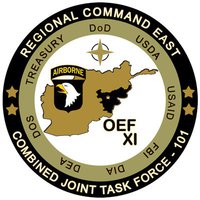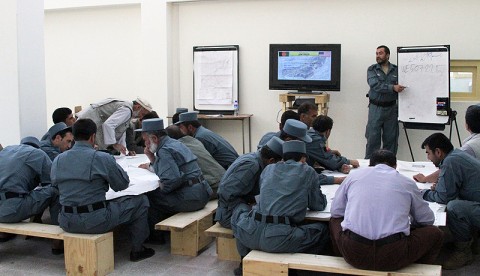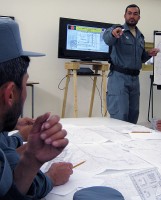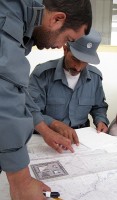Written by U.S. Air Force 2nd Lt. Jason Smith Panjshir Provincial Reconstruction Team
 Panjshir Province, Afghanistan -– Afghan National Police in the Rokha district of the Panjshir province are taking the lead in training much-needed skills to other members of the ANP.
Panjshir Province, Afghanistan -– Afghan National Police in the Rokha district of the Panjshir province are taking the lead in training much-needed skills to other members of the ANP.
ANP Captain Safat Ullah Sangee, Panjshir Operations Coordination Center-provincial, spends his days teaching map and compass reading techniques to police in each of the seven districts in the valley.
July 13th was the second day of Sangee’s three-day course at the Rokha Police Headquarters. Some of the things Sangee taught included how to use a protractor with a map, give grid coordinates, find grid coordinates, identify terrain features, and measure distance between points.

“I have almost four months training in map reading in Kabul,” said Sangee, a nine-year ANP veteran. “The Canadians taught us.”
Sangee said map reading is necessary for ANP because they will not always be working in the same area. He said even a policeman who knows his own district may have to respond to other districts in the province, or even to other provinces.
U.S. Army Sgt. 1st Class Stephen Jennings, Task Force Wolverine Embedded Training Team with Provincial Reconstruction Team Panjshir, said Sangee attended the ETT’s “Train the Trainer” course for map reading. He said Sangee was an outstanding student and has been an “awesome” teacher.
“This is district six for Capt. Sangee,” said Jennings, an Underhill, VT, native. “The response from the ANP students has been overwhelming. He’s been doing a great job.”

Rhoka ANP Training Officer Sefatmir said having an Afghan teach the class makes it easier for his men to learn.
“We can easily learn from Afghans because we can understand them easily, and they know how to teach us,” said Sefatmir. “If (Americans) try to teach, it will take a very long time. The teacher will say something and then it will need to be translated by someone who isn’t an expert in the field that’s being taught.”
U.S. Air Force Lt. Col. Curtis Velasquez, Panjshir PRT commander and auxiliary police officer for Fairfax County Police Department, VA, agrees that learning from another expert in the field who speaks the same language makes training more productive.
“There are certain terms and concepts that police forces use that are unique to the field,” said Velasquez. “Training can be a lot more effective if you’re teaching or learning from people who use the same terminology. I think the training Capt. Sangee provides is a great example of how an expert in one area of police work can offer quality training to others in the same field.”
Throughout day two of the training, Sangee ran an interactive class. He instructed from a map, dry-erase board and computer presentation on a large flat-screen TV. The students participated often, and from time-to-time, the group would find something to laugh about.
 Although the ETT interpreters moved among the students helping where they could, the U.S. Army ETT members stayed in the back of the room for the whole class in an observation role.
Although the ETT interpreters moved among the students helping where they could, the U.S. Army ETT members stayed in the back of the room for the whole class in an observation role.
“Over the nine years we’ve been here, training has been plug-and-play,” said Jennings. “Now, it’s self-sustaining, and it’s on the Afghans to provide the training.”
Jennings said the self sustainment is important so “we can go home.”
“It has been a pleasure having members of our ETT assist the Afghan National Police,” said Velasquez. “Also, having some law enforcement experience from a great police department like Fairfax County has really helped me work better with the ANP.”
Day three will be GPS training, said Jennings. After the group finishes the last district with the map and compass course, they will look at offering some training in close-quarter combat with weapons and room clearing procedures.


